Part 3
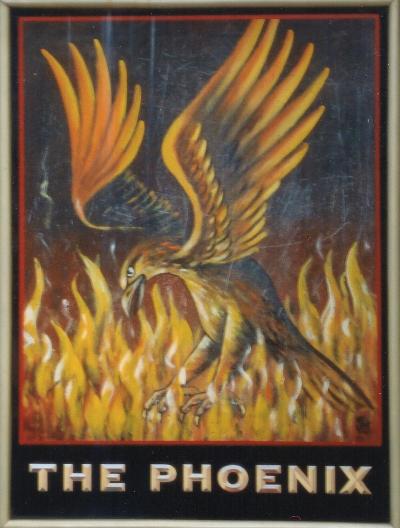
The sign of The Phoenix in York back in 2011 would seem an appropriately hopeful start to the third and last part of this Virtual Pub Crawl. In silhouette and black & white, people are beginning to return to their pubs and evacuated summer gardens:
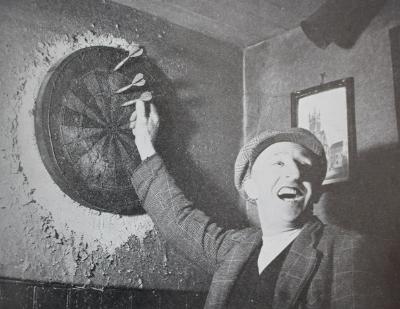
Uncle Barnabas returns with a vengeance – turning to guffaw in irony at his score of 101 at The Green Man in late 1948: “Top that Eric!”[i] The dartboard at The Green Man, was well-known to be affixed to the wall with a cowpat.[ii]
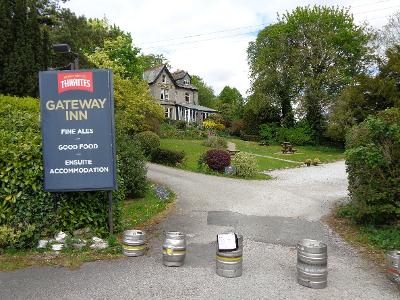
After another wave of muddled commands and counter-restrictions were suggested by virus-brained Boris[iii] and his increasingly reluctant acolytes, in the wake of VE[iv] day, I passed the Gateway Inn. In its sheltered location just off the normally busy Hawkshead Ferry roundabout, north of Kendal, this remained, on 13th May 2020, Closed for the Duration. Like the seven other rural pubs encountered and the dozen or more in Kendal, the Gateway is still a place not to rest. Traffic may be steadily increasing, but both town and lanes were pleasantly quiet. Those lost halcyon days . . . is that how “lockdown” (phase one) will come to appear in retrospect to the lucky ones; to the walkers and cyclists?
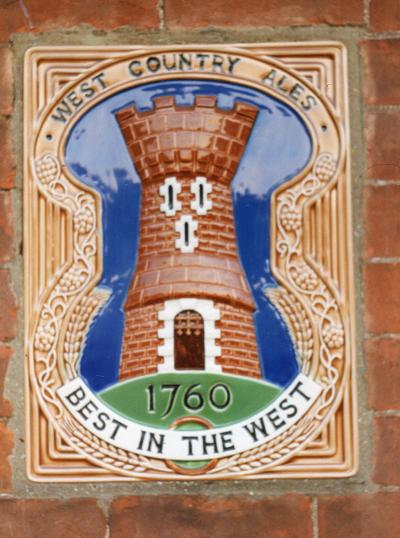
Ceramic wall plaque somewhere in Gloucestershire, May 1998
Part of the reason for my cycle was to catch some of the VE day decorations in the villages, but sadly, most had been tidied away[v] . . . To separate the fight for freedom from jingoism is never easy. A gateway in Levens village had two surreal tributes using hollowed uniforms draped around its posts. The left-hand, formed a tribute to the NHS; the right-hand, stood in for a desiccated Corporal Jones – his two favourite Dad’s Army[vi] catch phrases chalked on slates nearby: “Don’t Panic” and “They did not like it up ‘em.”
Such phrases, like supposed national characteristics, can be funny or insulting. Brexit tips us towards the insulting end, the potential value of personal self-reliance, becoming isolationism in a nation. As a child my surname was always problematic. At school, other kids clicked their heels or called me “Von Freiesleben”, and in games on the housing estate I often had to play the Nazis – not just one, but all of them, by land, sea and air, and always without a chink of reasonableness; always as relentless as Daleks[vii]. Luckily, my aunt[viii] had given me a Luger cap gun that was so believable that nowadays the police would confiscate it. In fact, robbing a bank would’ve been a simpler, more worthwhile pastime. In truth, our family connection to Germany was remote. My Grandad’s forbears left Leipzig for Brazil in the 1870s, his father marrying an Englishwoman, Kathleen Elizabeth Ingliss-Ewings, in London in 1901. Sailing back to Brazil together, my Grandad was born in Santa Maria, Rio Grande do Sul, in 1905. Returning to England, as an adult he married a Londoner in 1932[ix]. During the War, with a Brazilian rather than a German passport, he was fortunately classed a “friendly alien”, trusted to work as a lorry driver by day and firewatcher by night. Meanwhile, on my mother’s side, my other Grandad, Fred Gee[x], made light of his involvement in the Desert[xi] and Italian Campaigns – claiming to have drunk his way up through Italy. If he had received any medals, he probably would have flogged them – or painted them a different colour!
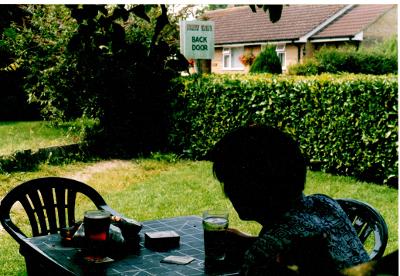
The garden of The New Inn, on a Summer journey of August 2003. The pub might have a dull name but that of the village, Dowlish Wake, in Somerset, makes up for it. As I’d lived in nearby Ilminster in 1983, the pub garden was distantly familiar and warmly relaxing. Though the New Inn survives, it looks from photos, as if the garden area may have undergone some redevelopment?
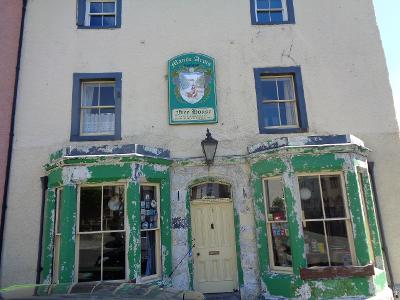
One of the more irritating facts about the internet is how many sites are not dated . . . but as a 2020 date appears at the very bottom of their opening page, I assume the Manor Arms, Broughton-in-Furness[xii], is taking being Closed for the Duration as an opportunity to renovate.
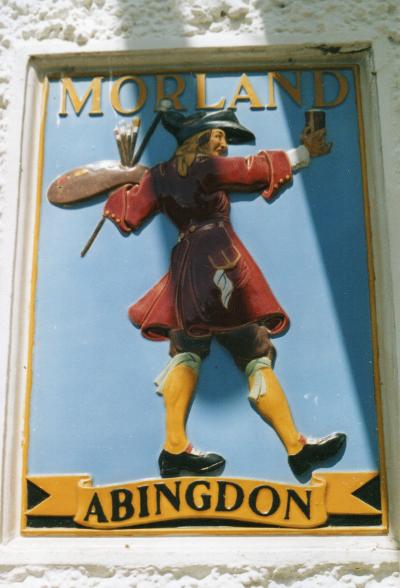
Both the West Country Brewery in Cheltenham a few photos back, and the Morland Brewery in Abingdon, produced fine ceramic wall plaques. In 2003, the one immediately above belonged to the Fleur de Lys at East Hagborne in Oxfordshire. Neither brewery remains in operation, but at least some of the Morland’s buildings were converted to residential use. Cheltenham’s brewery was demolished in 2004 to become the site of a shopping centre: Welcome to the future (or maybe the past) . . . which reminds me of the Hawkwind coda[xiii] to Space Ritual – probably more ideal as a theme for climate change than “lockdown”. Bizarre, but perhaps characteristic, that general populations will tolerate “lockdown” for a virus generated by human tampering, while barely considering the infinitely greater threat of climate change.
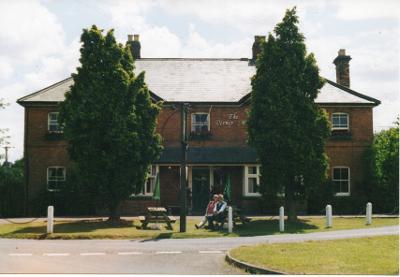
If Brill, at the end of the Brill & Wotton Tramway[xiv] was for 36 years, the ultima Thule of Metroland[xv], then Verney Junction[xvi] came a close second[xvii]. No outer commuter suburbs ever developed here, 50 miles from Baker Street. The nearby station hotel – seen above, in July 2003 – can never have been busy. Back in 1979, I used to walk to this middle-of-nowhere pub, alone or in company from Redfield[xviii] – sometimes along the virtually disused railway track, carefully listening for the very occasional freight or empty stock working between Bletchley and Aylesbury. At that time, the generally deserted Verney Arms had an uncommon selection of records on its juke box – King Crimson and Leonard Cohen for two examples. Apparently, the remaining railway tracks through the station were “abandoned in place in 1993 . . . rusted beyond use and in overgrown state, although modern signage still warns travellers to watch for approaching trains.[xix]”
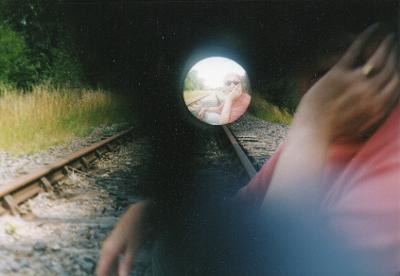
On a visit from Devonshire to see my parents, we all decided to go for a walk near that one-time frontier of Metroland. Surprised that the Verney Arms was still in business we naturally had a drink before continuing to the old station and railway. Not realizing that the route had been entirely abandoned, we moved along the tracks with caution. The photo above – the strangest I ever took of my mum – doesn’t involve any camera trickery or image manipulation. Holding the camera lens of my proper, 35mm Zenit camera, onto the wide end of a pair of binoculars, it somehow took a bit of each view – giving my mum the enviable (?) ability to be in two places at once.
Except for taking photos through whatever cheap pair of sunglasses I have in my pocket (increasing the 70s look or rusty light of certain views) I’ve never got the hang of filters or effects.
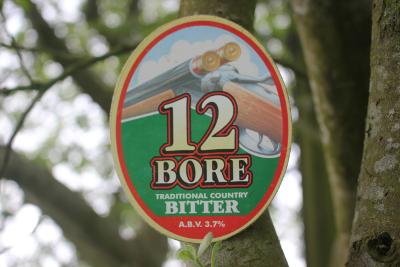
Did whoever brewed and named 12 Bore – it’s a genuine pump label[xx] nesting in this willow tree – do so in all seriousness? Or was it intended as a middle-class incomer joke at the expense of (supposedly) dim-witted, cider-pickled yokels? At 3.7 ABV[xxi], it’s not exactly going to blow your head off. Air Rifle or Spud Gun would have been more accurate.
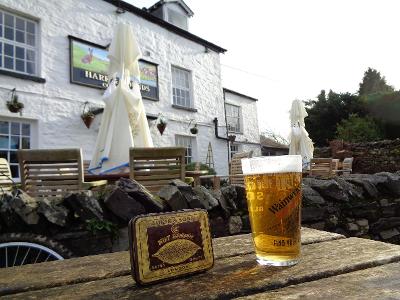
A smell of woodsmoke scents the air / The life inside looks easy /The best thing about dreams / is not needing to tidy them at the end.[xxii] Bowland Bridge, February 2020.
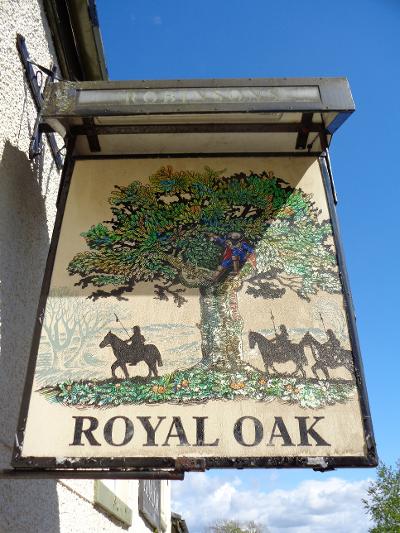
Another Now view of the less weathered side of the Closed for the Duration, Royal Oak – situated at the high end of Lindale, Cumbia, 2nd of May 2020
North Devon was the first distinctively different area I was to discover which was out of connection – moving to a caravan there in 1980. Before the North Devon link road was built between Tiverton and Barnstaple, inland North Devon was another world. The only way I could achieve a personal psychological shift as great now, would be to move to rural Chile. Long before I moved back to the region in 1996 the whole elder generation of people, whom mostly, I’d never quite known, had gone. They had welcomed the road – in 1980 the collection of milk in churns[xxiii] had only just ended[xxiv] – but it shattered their world, with holiday home ownership no doubt disenfranchising many.
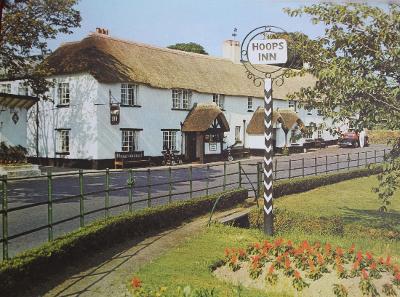
The Hoops Inn at Horns Cross – is still a pub and hotel and still beautiful to look at . . . it’s just a shame about the road. In this photograph taken from Old Inns in Colour, Batsford, 1958, the road looks relatively quiet, but even by 1980 it wasn’t, especially in the summer. About 6 miles west of Bideford, on what is now grandly known as the Atlantic Highway, it would be inadvisable to cycle the A39 for more than a mile or so. By 1996 the nearside garden area and distinctive, chevroned post had long gone – though traces of the iron fence remain to this day in unruly undergrowth.
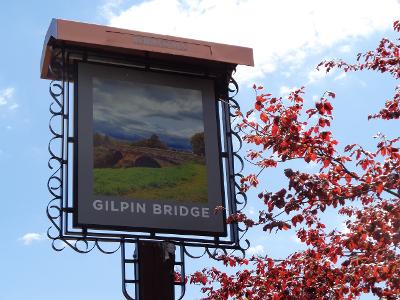
I don’t know whether The Gilpin Bridge (Closed for the Duration, 14th May 2020) was once as intimate with the main road as the Hoops Inn, but these days it benefits from being on a slight layby to a manic section of dual carriageway – so pleasantly reduced by “lockdown”. It is here that the road up the Lyth Valley, branches north. Cited in the Lonely Planet’s list of the “most beautiful places on earth”, perhaps I should keep quiet about it? Sadly, the sign is a photograph rather than a painting and the other side only has lettering. Though always preferring slow, obscure routes over motorways, as we know from playing the pub game[xxv] with our children, proper pub signs are a dying art . . .
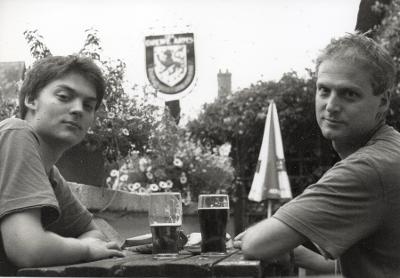
If I stare at this time-release photo from the 6th Summer Cycle of July 2004, featuring The Drewe Arms, at Drewsteignton on the very edge of the magnificent, one and only, Dartmoor, even without a drink or two, I can easily make it flow into colour . . . yet in some ways, black and white can be more real than reality – as if the colour world is equivalent to too much choice when it comes to crisp flavours! “Why do we need any flavours but PLAIN,” my dad used to protest, which inevitably led to “There is just too much CHOICE nowadays” – a statement which has become increasingly obvious in a decadent culture. Smokey Bacon was my favourite as a kid. Recently, helping my son move house, we found an abandoned, year-over-the-date, packet of crisps: Pigs-in-Blankets flavour! Probably bought by his younger brother, we were relieved to discover that they were basically Smokey Bacon.
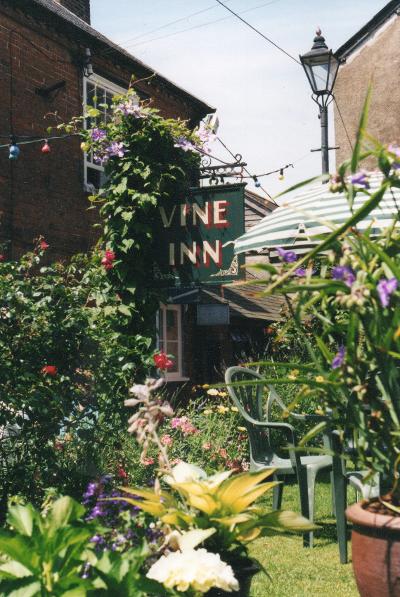
11th July 2003, Honiton, Devonshire. Whether in black and white or colour, the protean capacities of The Vine Inn, know no bounds . . .
© Lawrence Freiesleben
Cumbria, May 2020
NOTES
[i] A good friend of George Orwell’s, Barney had soberly examined and blessed the proofs of 1984 a few weeks earlier during an eventide session at the Green Man.
[ii] The photograph comes from English Inns Illustrated, Odhams Press Ltd, 1951]
[iii] https://www.theguardian.com/commentisfree/2020/may/12/civic-duty-prime-minister-boris-johnson-coronavirus
[iv] https://en.wikipedia.org/wiki/Victory_in_Europe_Day
[v] From an email of 13th May 2020: “Shame there were no tanks. Sedgewick was reputed to have two tanks on display. Wouldn’t mind a tank. Solar powered of course. Could be useful in the future!”
[vi] https://www.imdb.com/title/tt0062552/
[vii] https://en.wikipedia.org/wiki/Dalek
[viii] My mum didn’t approve of toy guns
[ix] With thanks to my sister from whose detailed research this brief sketch is taken. Her interest in family genealogy, led her not only to Leipzig just after the Berlin Wall fell, but was also a major factor in her choosing to live and work in Brazil for 18 months in the 1990s.
[x] Fred Gee features heavily in Devon and Derby – An English Journey Digression:
http://internationaltimes.it/devon-and-derby-an-english-journey-digression/
[xi] https://en.wikipedia.org/wiki/North_African_campaign
[xii] https://manorarmsthesquare.co.uk/#
[xiii] https://www.youtube.com/watch?v=ap-zRtP48cE
[xiv] https://en.wikipedia.org/wiki/Wotton_railway_station_(Brill_Tramway)
[xv] Reading a fascinating Guardian article about Metroland https://www.theguardian.com/cities/2015/sep/10/metroland-100-years-england-original-vision-suburbia I realised that since the 70s, I’ve quite inaccurately thought of Metroland as not really counting until the train is beyond Northwood or Moor Park. To me, Great Missenden or Wendover, their surrounding fields, hills and hamlets, were the true Metroland. Subconsciously taking account of sixty years of despoliation since 1915 (during which era – despite not much difference in journey times – Wendover must’ve seemed remote compared to 1975), I‘d shifted the ideal of Metroland 20 miles further out. Blithely, and despite many contradictory and enjoyable explorations of my own, I’d abandoned most of the areas highlighted by the Guardian’s article, to London’s albeit deeply fascinating, sprawl.
[xvi] https://en.wikipedia.org/wiki/Verney_Junction_railway_station
[xvii] Even John Betjeman in his still definitive 1973 film, Metroland, (see: https://en.wikipedia.org/wiki/Metro-Land_(1973_film) never gets further in person than Quainton Road, on the Metropolitan. North of here and constructed to continental loading gauge, the Great Central built what later became known as the London Extension. This aimed to fulfil the ambitious 1870s scheme of its Chairman, Edward Watkin, to complete a route to the continent via a channel tunnel – an idea first suggested by French mining engineer Albert Mathieu as long ago as 1802. See also: https://www.gcrailway.co.uk/brief-history/
[xviii] The rural community mentioned in part 1, where I lived from early 1979 to late August 1980.
[xix] This could all change by 2023: https://www.cambridge-news.co.uk/news/cambridge-news/oxford-cambridge-expressway-brain-belt-14010969 See also:
https://www.theguardian.com/commentisfree/2016/dec/10/chris-grayling-oxford-cambridge-line-verney-junction
[xx]https://www.google.com/search?source=univ&tbm=isch&q=beer+pump+labels&sa=X&ved=2ahUKEwiX2MGz47fpAhVWRhUIHV_UCrgQ7Al6BAgKED8&biw=1440&bih=789
[xxi]https://www.google.com/search?q=ABV+range+of+beer&oq=ABV+range+of+beer&aqs=chrome..69i57j0.28918j0j7&sourceid=chrome&ie=UTF-8
[xxii] http://internationaltimes.it/the-best-thing-about-dreams-is-not-having-to-tidy-them-up-at-the-end/
[xxiii] https://en.wikipedia.org/wiki/Milk_churn Once the local farmer Mr Shambrook, and I learned to understand each other, he used to give me proper warm milk, un-fiddled with, straight from his cows. Milk has never tasted so good. These cows knew the way to their fields – many of which were half a mile away by lane and involved several lane junctions. If they weren’t back at the right time, he just “hollered” from his yard and they hastened home. Many had names, but he obviously felt obliged to get out of that habit.
[xxiv] https://api.parliament.uk/historic-hansard/lords/1978/jul/10/milk-collection
[xxv] https://www.treasuretrails.co.uk/hidden-treasure/free-stuff/travel-games/kids-car-journey-games-road-pub-sign I was always on the lookout for The Millipede’s Wedding!
